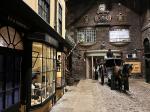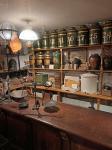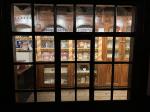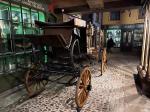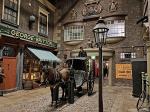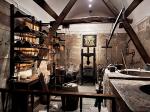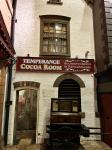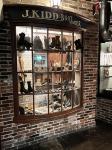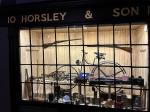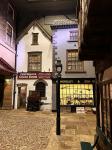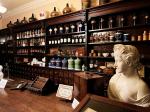Monday 22nd January 2024
This was my second visit to the museum just recently, such was my fascination and interest of the Victorians in York.
On this morning’s visit I stayed in Kirkgate, this is a recreated street built inside the Castle Museum and shows what life must have been like during the Victorian period in York between 1870 – 1901. The shop fronts as well as many of the objects on display are all original. The layout reflects the cityscape of a typical Victorian high street with the eclectic mix of shops and small workshops. There are well over thirty shops along Kirkgate, some of which I have described and photographed below.
As soon as you walk onto Kirkgate your imagination takes you back to the Victorian era, one of the first things that hits you as you walk along the cobbled stones is the variety of smells, the majority of which are not very pleasant. The staff are extremely informative and dressed in period costume bring the street to life. The Hansom cab on display, would have been a common site in Victorian York, although the cab on show was built in Birmingham, its designer was Joseph Hansom an architect who was born in York. The Hansom cab was the equivalent of today’s taxis.
William Francis Greenwood were Antique dealers and furniture makers, established in York in 1829, they owned the well-known 'Tudor House' in Stonegate (now number 33 Stonegate), York during the early 20th century, which was set up as a series of period rooms with antiques for sale.
J Kidd was a boot and shoemaker in York, The company was established in the early 1800s and continued to operate until the mid-1900s. The company was known for its high-quality boots and shoes, which were made using traditional methods and materials. J. Kidd’s boots and shoes were popular among the upper classes of society, and the company was awarded several royal warrants. In 1896 there were 137 boot and shoemakers listed in the Trade Directory in York, the shoe shop was just as important as the local greengrocer.
Kendricks Toy Dealers and Fancy Repository was an upmarket toy shop for wealthier families, poorer children would have had their toys made for them by family members such as skipping ropes or wooden tops. Parents saw toys as educational; girls were taught domestic skills through the toys.
Thomas Ambler was the family grocer and Provisions dealer, his shop was originally situated just behind the city walls, and most of their customers came from Nunnery Lane, a working-class district of York. This shop offered a one stop general store for food such as tea, sugar, bacon, and butter as well as household goods such as soap, boot laces and tobacco.
The Temperance Cocoa Room. Alcohol consumption was very much part of everyday life during the Victorian era in York. Alcohol was often prescribed by doctors and was considered to be restorative! The Temperance societies formed in the 1830’s encouraged followers to moderate their alcohol consumption. During the Kirkgate period Francis Bacon a former domestic servant ran the Ebor and The York Temperance Club and Cocoa Rooms where customers could find cheap accommodation, rent rooms, and buy hot dinners, teas, suppers, and cocoa.
Horsleys and Sons were Gunsmiths in York from 1856, with premises down Coney street. By the end of the 1880’s the firm was also selling outdoor sporting equipment as well as running a shooting range. By 1900 they were also listed as a cycle agent.
Edward Allen was a taxidermist, and his shop displays specimens which he had preserved. His business was established in 1846, but he took over the business in 1880.
CE Barton was a confectioner, baker and caterer who opened his first shop on Davy gate, York in 1881. He specialised in making butter scotch as well as running his own ginger beer brewery.
John Saville was the Pharmaceutical Chemist originally located on Goodramgate in York in May 1876. John Saville was a pharmaceutical chemist who founded one of York’s longest-lasting retail and pharmaceutical chemist businesses in May 1876. The chemist mixed and prepared pills, powders, lotions and tonics. He also sold perfumes, sauces, inks as well as a range of cleaning products. He had a wide customer base including leading business leaders to those less fortunate people living in the slums in the surrounding area, to those people Mr Saville became a surrogate doctor.
Leak and Thorp were drapers and house furnishers, they were sometimes referred to as todays equivalent of ‘Selfridges of York’. The firm was established on March 11, 1848, when William Leak opened premises at 35 Parliament Street. He began with just one or two assistants, and turnover at first was not large, according to company ledgers. Before long, Mr Leak was joined in the business by Mr HB Thorp, and the business took on the name by which it was to become so familiar to generations of York people. In 1869, the shop moved to Coney Street. Customers could buy dress materials, gloves and hosiery, millinery, and underclothing. Inside shelves were stacked with bolts of fabrics including cotton prints and floral chintz used for upholstery. The 1871 census shows the shop employed 14 shop men, 16 teenage apprentices, 11 shop women and seven servants.
These are just a small selection of some of the shops down Kirkgate, round the back is the Rowntree Snicket which houses the Tallow Factory, and I will describe this and some of the other shops after my next visit. Now time for a coffee and cake in the museums café.
|


